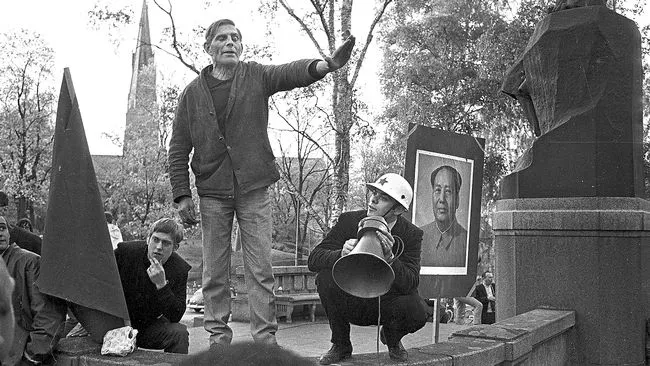 One of the most bizarre events in modern Swedish history is the rise and fall of the Rebel movement (Rebellrörelsen). It lasted for less than six months. The movement was led by Francisco Sarrion, a spanish stuccoer and translator, living in Sweden. He had the gift of speech. He had visited China in the mid 1960s and became inspired by the on-going cultural revolution. Back in Sweden the Rebels (also called red guards or double-maoists) tried to take over KFML (Communist League Marxists-Leninists), which they thought were "false authorities", revisionists and too soft. The Rebels were almost without exception, students, and gathered in total about 300-400 people (figures vary) primarly in the university towns Stockholm and Uppsala and to a lesser extent, Lund. The Rebels thought that the end justified the means. "A revolution is not a dinner party or writing an essay, or painting a picture, or doing embroidery; it cannot be so refined, so leisurely and gentle, so temperate, kind, courteous, restrained and magnanimous. A revolution is an insurrection, an act of violence by which one class overthrows another", wrote Mao. The occupation of the Student Union Building in Stockholm in May 1968 provided an opportunity to whip up support for the new movement. They didn't succeed. First, not many understood the incomprehensible litany. The Rebels were constantly quoting Mao whether appropriate or not; "For the present upsurge of the peasant movement [in Hunan Province] is a colossal event." Second, the majority of the students were more interested in university reforms and study conditions. When success failed, one group turned right and became just sympathizers or returned to their former political affiliations. The other group - the hardliners - turned inwards. The rebel leader, Francisco Sarrion, was a charismatic man, mastered demagogic tricks and created a sense of urgency and ecstasy. Communist cells, like monastery cells, were created to educate, train and harden themselves. Puritanism and ascetism ruled. The bourgeois soul should, figuratively and literally, be whipped out of of the body. No smoking, no alcohol and no drugs. The attitude towards sex was ambigious. A married couple who wanted to have sex needed a permission from the cell members. This was granted if the couple promised that it would be conducted in a "proletarian" way (namely, thinking of Mao under the act). In a cell in Uppsala two rebels were attracted to each other and had consensual sex. However, afterwards the woman was verbally attacked by the man. He described their temporary sexual relationship in such a way that the woman's "bourgeois consciousness" was stronger than his "proletarian consciousness". She was subjected to merciless criticism from other cell members and was expelled. The hardliners burned books, destroyed art, smashed vinyl records, kidnapped children from their parents, forced comrades to break with their parents, devoted themselves to endless criticism and self-criticism to erase every trace of their reprehensible life, made house arrests, interrogated and assaulted fellow comrades and even planned to commit murder. A stubborn comrade that would not bow down was tied to a tree in Lill-Jansskogen (a recreational area in northern Stockholm), but the potential murderers were interrupted by the police who in turn had been tipped off by a passing orienteer. Allegedly, they all went home and drank tea instead. To harden themselves the hardliners slept on floors, arranged swims and gymnastics like quorum, with a red banner including opening and closing reading of Mao's Little Red Book. The paranoia grew and the overstepping escalated. Anyone could become a victim. The Rebel movement could never develop into a terror organization, like Baader-Meinhof. They were too busy terrorizing each other. The inevitable end came in late July 1968 after a "People's Court" trial in a student assembly hall in Uppsala (the assembly hall actually belonged to the arch enemy, the socialdemocrats student club Laboremus). All rebels had been invited, not only the hardliners. The accused were denounced as "left adventurists" by Francisco Sarrion. They were mocked at and spat on. Four members were forced to sit on the floor with their hands over the heads. No eye contact with them were allowed to avoid to evoke feelings of pity or sympathy. The accused were convicted and incarcerated. Many non-cell rebels were shocked and appalled of what the movement had become and a few of them spoke up. The opposition urged the cell rebels to come to their senses and to overthrow Francisco Sarrion. There was a clear majority for a dissolution of the movement. All rebels, except five of the most devoted, zealous and militant Sarrion followers, left the assembly hall. The Rebel movement died there and then. However, the movement still held many ex-rebels in a firm grip. Some thought that they would be persecuted, caught up and even killed. Many rebels were in bad shape and deeply traumatized. They had worn themselves out. Some needed psychiatric help, others went abroad or hided at an unknown location before they dared to return. The despised and mocked family institution became a place for resting and healing. Slowly, but surely things got back to normal. And what about "the infallible" sect leader Francisco Sarrion? He moved back to Spain, lived the last years of his life in the Canary Islands, working in the tourist industry until his death in 1996.
One of the most bizarre events in modern Swedish history is the rise and fall of the Rebel movement (Rebellrörelsen). It lasted for less than six months. The movement was led by Francisco Sarrion, a spanish stuccoer and translator, living in Sweden. He had the gift of speech. He had visited China in the mid 1960s and became inspired by the on-going cultural revolution. Back in Sweden the Rebels (also called red guards or double-maoists) tried to take over KFML (Communist League Marxists-Leninists), which they thought were "false authorities", revisionists and too soft. The Rebels were almost without exception, students, and gathered in total about 300-400 people (figures vary) primarly in the university towns Stockholm and Uppsala and to a lesser extent, Lund. The Rebels thought that the end justified the means. "A revolution is not a dinner party or writing an essay, or painting a picture, or doing embroidery; it cannot be so refined, so leisurely and gentle, so temperate, kind, courteous, restrained and magnanimous. A revolution is an insurrection, an act of violence by which one class overthrows another", wrote Mao. The occupation of the Student Union Building in Stockholm in May 1968 provided an opportunity to whip up support for the new movement. They didn't succeed. First, not many understood the incomprehensible litany. The Rebels were constantly quoting Mao whether appropriate or not; "For the present upsurge of the peasant movement [in Hunan Province] is a colossal event." Second, the majority of the students were more interested in university reforms and study conditions. When success failed, one group turned right and became just sympathizers or returned to their former political affiliations. The other group - the hardliners - turned inwards. The rebel leader, Francisco Sarrion, was a charismatic man, mastered demagogic tricks and created a sense of urgency and ecstasy. Communist cells, like monastery cells, were created to educate, train and harden themselves. Puritanism and ascetism ruled. The bourgeois soul should, figuratively and literally, be whipped out of of the body. No smoking, no alcohol and no drugs. The attitude towards sex was ambigious. A married couple who wanted to have sex needed a permission from the cell members. This was granted if the couple promised that it would be conducted in a "proletarian" way (namely, thinking of Mao under the act). In a cell in Uppsala two rebels were attracted to each other and had consensual sex. However, afterwards the woman was verbally attacked by the man. He described their temporary sexual relationship in such a way that the woman's "bourgeois consciousness" was stronger than his "proletarian consciousness". She was subjected to merciless criticism from other cell members and was expelled. The hardliners burned books, destroyed art, smashed vinyl records, kidnapped children from their parents, forced comrades to break with their parents, devoted themselves to endless criticism and self-criticism to erase every trace of their reprehensible life, made house arrests, interrogated and assaulted fellow comrades and even planned to commit murder. A stubborn comrade that would not bow down was tied to a tree in Lill-Jansskogen (a recreational area in northern Stockholm), but the potential murderers were interrupted by the police who in turn had been tipped off by a passing orienteer. Allegedly, they all went home and drank tea instead. To harden themselves the hardliners slept on floors, arranged swims and gymnastics like quorum, with a red banner including opening and closing reading of Mao's Little Red Book. The paranoia grew and the overstepping escalated. Anyone could become a victim. The Rebel movement could never develop into a terror organization, like Baader-Meinhof. They were too busy terrorizing each other. The inevitable end came in late July 1968 after a "People's Court" trial in a student assembly hall in Uppsala (the assembly hall actually belonged to the arch enemy, the socialdemocrats student club Laboremus). All rebels had been invited, not only the hardliners. The accused were denounced as "left adventurists" by Francisco Sarrion. They were mocked at and spat on. Four members were forced to sit on the floor with their hands over the heads. No eye contact with them were allowed to avoid to evoke feelings of pity or sympathy. The accused were convicted and incarcerated. Many non-cell rebels were shocked and appalled of what the movement had become and a few of them spoke up. The opposition urged the cell rebels to come to their senses and to overthrow Francisco Sarrion. There was a clear majority for a dissolution of the movement. All rebels, except five of the most devoted, zealous and militant Sarrion followers, left the assembly hall. The Rebel movement died there and then. However, the movement still held many ex-rebels in a firm grip. Some thought that they would be persecuted, caught up and even killed. Many rebels were in bad shape and deeply traumatized. They had worn themselves out. Some needed psychiatric help, others went abroad or hided at an unknown location before they dared to return. The despised and mocked family institution became a place for resting and healing. Slowly, but surely things got back to normal. And what about "the infallible" sect leader Francisco Sarrion? He moved back to Spain, lived the last years of his life in the Canary Islands, working in the tourist industry until his death in 1996.
Featured
"The Rebels"
Konztroll
Hits: 1500
